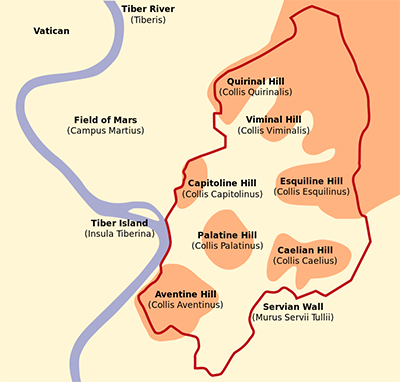The Seven Hills of Rome
Rome was famously founded on seven hills. Those seven hills are the Aventine, Caelian, Capitoline, Esquiline, Palatin, Quirinal, and Viminal. 
One of the stories of Remus and Romulus, the legendary twins who were said to have founded Rome, was that Remus wanted to build on the Aventine Hill and that Romulus preferred the Palatine Hill. Romulus's victory in this struggle, as the story goes, meant that the city was founded on the Palatine on April 21, 753 B.C. Each of the seven hills had its own culture originally, and the people living on those various hills worked together to drain the marshes in between and, later, build the Servian Walls. Plebeians primarily lived on the Aventine Hill, which was also home to the Temple of Diana and the Temple of Minerva. The Caelian Hill was the preferred location of the wealthy during the Roman Republic. The Capitoline Hill had the Tarpeian Rock, from which Rome at times tossed villains to their deaths below. This hill was also home to the Temple of Juno Moneta. Tallest and largest of the seven hills, the Esquiline Hill was the setting for several well-known constructions, including the Golden House of Nero, the Temple of Claudius, and the Baths of Trajan. Many an emperor had his palace built on the Palatine Hill, which also housed a number of temples among them the Temple of the Magna Mater and the Temple of Apollo and Vesta. The northernmost of the seven hills is the Quirinal Hill. The Sabines lived there in ancient times, as did Numa, the second king of Rome. The Viminal Hill was sparsely populated with buildings. Known to have been there were a Temple to Serapis built by Caracalla and the Baths of Diocletian. |
|
Social Studies for Kids
copyright 2002–2025
David White




